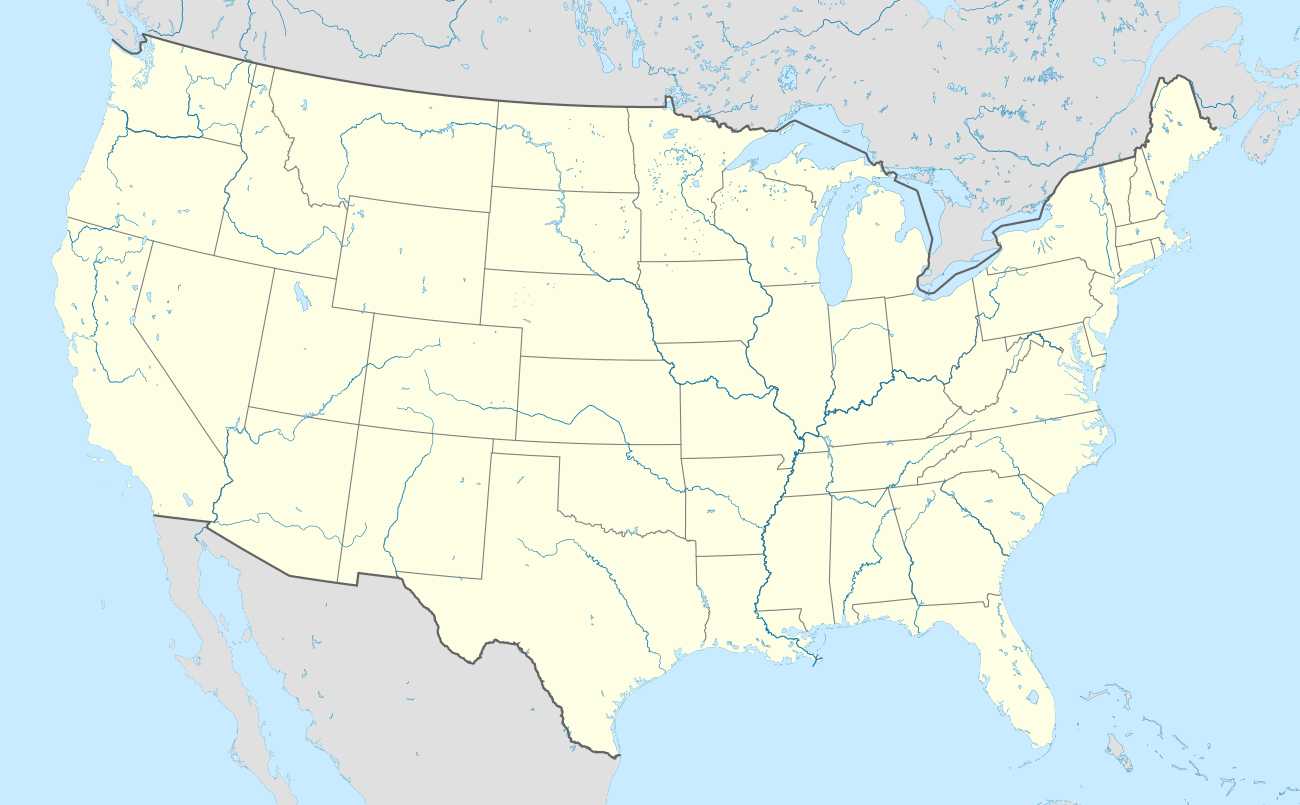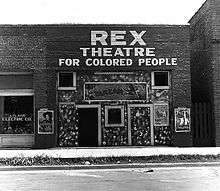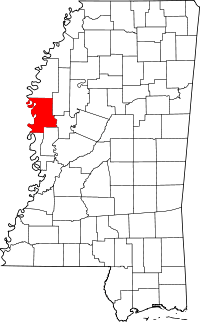Leland, Mississippi
Leland is a city in Washington County, Mississippi, in the Mississippi Delta. The population was 4,481 at the 2010 census. It was long a center of cotton culture, which is still an important commodity crop in the rural area.
Leland, Mississippi | |
|---|---|
 | |
 Leland, Mississippi Location in the United States | |
| Coordinates: 33°24′18″N 90°53′50″W | |
| Country | United States |
| State | Mississippi |
| County | Washington |
| Area | |
| • Total | 3.63 sq mi (9.41 km2) |
| • Land | 3.58 sq mi (9.28 km2) |
| • Water | 0.05 sq mi (0.13 km2) |
| Elevation | 125 ft (38 m) |
| Population (2010) | |
| • Total | 4,481 |
| • Estimate (2018)[2] | 3,863 |
| • Density | 1,111.08/sq mi (428.94/km2) |
| Time zone | UTC-6 (Central (CST)) |
| • Summer (DST) | UTC-5 (CDT) |
| ZIP code | 38756 |
| Area code(s) | 662 |
| FIPS code | 28-40280 |
| GNIS feature ID | 0672400 |
Background
Leland is located in the Mississippi Delta on the banks of Deer Creek. Since before the Civil War, farming is the basis of the local economy. Mississippi State University and the federal government maintain an agriculture research station at Stoneville on Leland's outskirts. Cotton, soybeans, rice and corn are the leading commodity crops.
A number of national and regionally noted blues musicians are from Leland. There are five Mississippi Blues Trail markers in Leland commemorating the small town's significant contribution to blues history. Highway 61, mentioned in numerous blues recordings, runs through the town and gives its name to the community's[3] blues museum. Leland is the burial place of the folk artist and blues musician James "Son" Thomas, who lived for many years near the railroad tracks. Thomas is buried beneath a gravestone donated by Mt. Zion Memorial Fund, to which musician John Fogerty of Creedence Clearwater Revival was a yearly contributor.[4][5]
Blues musician Johnny Winter spent part of his childhood in Leland. Winter's grandfather and father, a former mayor of Leland, operated J.D. Winter & Sons, a cotton business. One of the Blues Trail markers in Leland is dedicated to Winter.[6]
The community is the childhood home of puppeteer Jim Henson, who was born in nearby Greenville, but raised in Leland. Here he created the character of Kermit the Frog, a Muppet. The city has a museum along the banks of Deer Creek celebrating Henson's accomplishments.

Leland was selected as the site for the Mississippi Wildlife Heritage Museum, scheduled to open in 2016.[7]
Geography
According to the United States Census Bureau, the city has a total area of 2.1 square miles (5.4 km2), of which 2.1 square miles (5.4 km2) is land and 0.04 square miles (0.10 km2) (1.44%) is water.
Demographics
| Historical population | |||
|---|---|---|---|
| Census | Pop. | %± | |
| 1890 | 485 | — | |
| 1900 | 762 | 57.1% | |
| 1910 | 1,547 | 103.0% | |
| 1920 | 2,003 | 29.5% | |
| 1930 | 2,426 | 21.1% | |
| 1940 | 3,700 | 52.5% | |
| 1950 | 4,736 | 28.0% | |
| 1960 | 6,295 | 32.9% | |
| 1970 | 6,000 | −4.7% | |
| 1980 | 6,667 | 11.1% | |
| 1990 | 6,366 | −4.5% | |
| 2000 | 5,502 | −13.6% | |
| 2010 | 4,481 | −18.6% | |
| Est. 2018 | 3,863 | [2] | −13.8% |
| U.S. Decennial Census[8] | |||
As of the 2013 American Community Survey, there were 4,427 people living in the city. 74.3% were African American, 24.8% White, 0.1% Native American, 0.6% Asian, 0.1% from some other race and 0.2% from two or more races. 0.4% were Hispanic or Latino of any race.
As of the census of 2000, there were 5,502 people, 1,943 households, and 1,414 families living in the city. The population density was 2,670.2 people per square mile (1,031.2/km2). There were 2,095 housing units at an average density of 1,016.7 per square mile (392.7/km2). The racial makeup of the city was 32.01% White, 67.01% African American, 0.16% Native American, 0.13% Asian, 0.04% from other races, and 0.65% from two or more races. Hispanic or Latino of any race were 0.75% of the population.
There were 1,943 households out of which 36.9% had children under the age of 18 living with them, 38.9% were married couples living together, 27.7% had a female householder with no husband present, and 27.2% were non-families. 24.2% of all households were made up of individuals and 11.1% had someone living alone who was 65 years of age or older. The average household size was 2.82 and the average family size was 3.35.
In the city, the population was spread out with 31.9% under the age of 18, 10.6% from 18 to 24, 26.3% from 25 to 44, 18.8% from 45 to 64, and 12.4% who were 65 years of age or older. The median age was 30 years. For every 100 females, there were 88.1 males. For every 100 females age 18 and over, there were 78.6 males.
The median income for a household in the city was $25,678, and the median income for a family was $28,926. Males had a median income of $26,184 versus $20,693 for females. The per capita income for the city was $11,681. About 24.0% of families and 27.5% of the population were below the poverty line.
Education
The City of Leland is served by the Leland School District. Leland High School is the sole high school.
Notable people
- James "Son" Thomas, blues musician, gravedigger, and sculptor.
- Douglas A. Blackmon, Pulitzer Prize-winning author of Slavery by Another Name, grew up in Leland.
- Johnie Cooks, former college and professional football player at Mississippi State University and the NFL, is from Leland.
- Jim Henson, puppeteer and creator of The Muppets, grew up in Leland.
- Thelma Houston, singer/actress, was born in Leland.
- Antonio Johnson, professional football player.[9]
- Wadada Leo Smith, a jazz trumpeter and composer, is from Leland.
- Bob Taylor, baseball player.
- Johnny Winter, blues musician, spent part of his childhood in Leland.
- Matt Miller graduated at Leland High School in 1990; he is a Major League Pitcher .
- Eddie Cusic, blues musician, was born in Wilmot, near Leland, where he spent most of his life.[10]
References
- "2017 U.S. Gazetteer Files". United States Census Bureau. Retrieved Jan 6, 2019.
- "Population and Housing Unit Estimates". Retrieved October 1, 2019.
- "Leland Blues Project". Retrieved October 15, 2010.
- Yellin, Emily (1997-09-30). "Homage at Last for Blues Makers ; Through a Fan's Crusade, Unmarked Graves Get Memorials". The New York Times. ISSN 0362-4331. Retrieved 2019-02-01.
- "James "Son" Thomas". Mount Zion Memorial Fund. Retrieved 2019-02-01.
- "Johnny Winter - Leland". Mississippi Blues Commission. Retrieved November 3, 2015.
- "Mississippi Outdoor Hall of Fame". Mississippi Wildlife Heritage Museum. Retrieved November 3, 2015.
- "Census of Population and Housing". Census.gov. Archived from the original on May 12, 2015. Retrieved June 4, 2015.
- "Antonio Johnson". Mississippi State University Athletics. Retrieved November 3, 2015.
- "Eddie Cusic: Mississippi Folklife and Folk Artist Directory". Arts.state.ms.us. 1926-01-04. Retrieved 2015-08-13.
